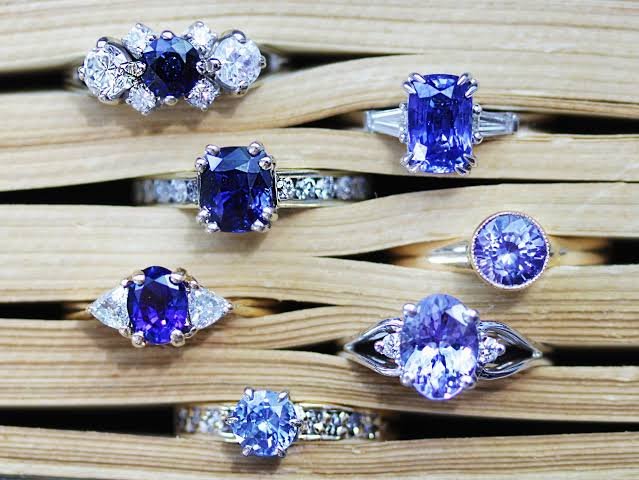
Sapphires are among the most coveted gemstones in the world. Known for their vibrant colors, especially the deep, mesmerizing blue that most people associate with them, sapphires have been symbols of nobility, truth, and wisdom for centuries. While blue is the most famous color, sapphires actually come in a variety of shades, each with its own unique charm. This article explores the world of sapphires, covering their origins, varieties, significance, and tips for purchasing and caring for them.
The Origins of Sapphire
Sapphires belong to the corundum family of minerals, the same family that includes rubies. The presence of trace elements like iron, titanium, and chromium gives sapphires their wide range of colors. These gemstones are primarily found in countries such as Sri Lanka, Myanmar, Madagascar, and Australia. Each location provides sapphires with different characteristics, often influencing their value and appeal.
Sri Lanka, historically known as Ceylon, is famous for producing some of the most beautiful sapphires in the world. The stones from this region, often called Ceylon sapphires, are renowned for their light to medium blue shades. Myanmar, formerly Burma, produces sapphires with a rich, deep blue color, often referred to as “royal blue.” These sapphires are highly sought after by collectors and connoisseurs.
Colors of Sapphire
Though blue is the most recognized sapphire color, these gemstones are available in almost every color of the rainbow. The range includes pink, yellow, green, purple, and even colorless varieties. The term “fancy sapphires” refers to these non-blue sapphires.
Blue Sapphire: This is the classic sapphire color, ranging from pale blue to deep, velvety hues. The most prized blue sapphires have a vivid, intense color without being too dark.
Pink Sapphire: Pink sapphires are growing in popularity due to their soft, romantic hue. The color intensity can vary from pale pink to vibrant magenta.
Yellow Sapphire: Often associated with wealth and prosperity, yellow sapphires range from pale lemon to deep golden shades.
Padparadscha Sapphire: One of the rarest types, this sapphire is a blend of pink and orange. Its name comes from the Sinhalese word for “lotus flower,” reflecting its delicate, peachy color.
Star Sapphire: A unique variety, star sapphires display a star-like pattern on their surface, known as asterism. This effect occurs due to needle-like inclusions within the stone.
Symbolism and Significance
Throughout history, sapphires have been revered for their beauty and symbolism. In ancient Greece and Rome, kings and queens believed that blue sapphires protected their owners from envy and harm. The clergy of the Middle Ages wore sapphires to symbolize Heaven, and it was believed that the gemstone attracted divine favor.
Today, sapphires are a symbol of fidelity, truth, and sincerity, making them a popular choice for engagement rings. The famous sapphire engagement ring worn by Princess Diana, and now by Kate Middleton, is a prime example of the gemstone’s enduring appeal.
How to Choose a Sapphire
When purchasing a sapphire, it’s essential to consider the “Four Cs”: Color, Clarity, Cut, and Carat weight.
Color: The color of a sapphire is its most critical factor. A vivid, intense hue with even color distribution is ideal.
Clarity: While most sapphires have some inclusions, stones with fewer visible inclusions are more valuable. Inclusions can affect the stone’s transparency and brilliance.
Cut: A well-cut sapphire will reflect light evenly across the surface, enhancing its natural beauty. The cut should maximize the stone’s brilliance and color.
Carat Weight: Sapphires are denser than diamonds, so a sapphire will appear smaller than a diamond of the same carat weight. Larger sapphires are rarer and, therefore, more valuable.
Caring for Your Sapphire
Sapphires are highly durable, ranking 9 on the Mohs scale of hardness, second only to diamonds. This makes them an excellent choice for everyday wear. However, to maintain their beauty, regular care is essential.
Cleaning: Use warm, soapy water and a soft brush to clean your sapphire jewelry. Avoid using harsh chemicals or ultrasonic cleaners, which can damage the stone or its setting.
Storage: Store your sapphire jewelry separately from other gemstones to prevent scratching. Use a soft pouch or lined jewelry box for safe keeping.
Conclusion
Sapphire are more than just beautiful stones; they are treasures steeped in history and symbolism. Whether you’re drawn to the classic blue or one of the many other shades, a sapphire is a timeless choice that will bring joy for generations. When cared for properly, sapphires retain their brilliance and continue to be a symbol of elegance and prestige.
FAQs
What is the most valuable color of sapphire? The most valuable color of sapphire is the deep, vivid blue known as “royal blue.”
Are sapphires only blue? No, sapphires come in many colors, including pink, yellow, green, and colorless varieties.
How can I tell if a sapphire is real? A real sapphire will be hard and resistant to scratching. A jeweler can confirm its authenticity using specialized tools.
Why are star sapphires special? Star sapphires are special because of the star-like pattern (asterism) that appears on their surface, which is caused by inclusions in the stone.
Can sapphires be worn every day? Yes, sapphires are very durable and suitable for everyday wear, but they should be cleaned and stored properly.
How should I clean my sapphire jewelry? You should clean sapphire jewelry with warm, soapy water and a soft brush. Avoid harsh chemicals and ultrasonic cleaners.







